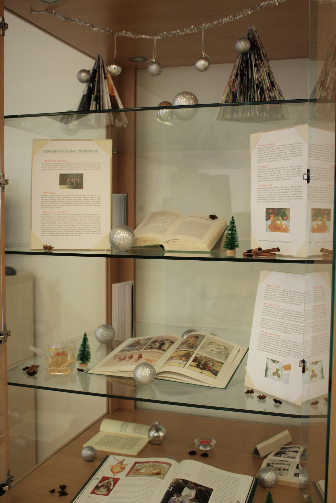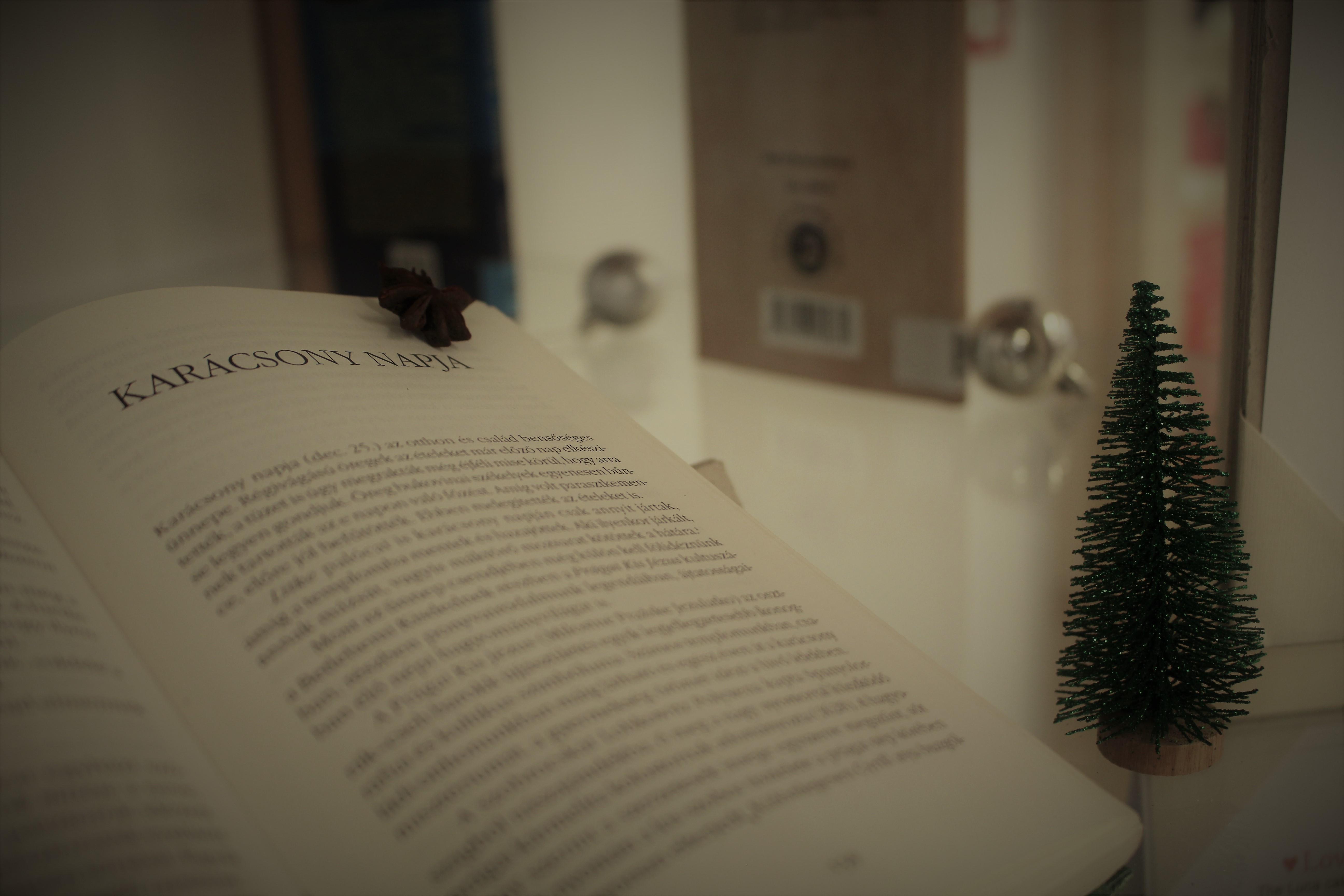Christmas Vitrine Exhibition – Hungarian Holiday Traditions

Come and visit the Library's brand new vitrine exhibition that is next to the Registration. This month's topic is how Hungarians celebrate Advent and Christmas.
Happy Holidays!
Advent Wreaths
In Hungary, the countdown to Christmas is marked by traditional advent wreaths. These beautiful holiday centerpieces feature four candles, representing faith, hope, joy and love, nestled in a bed of pine branches and ribbon. A candle is lit each Sunday leading up to Christmas, with the final candle lit on szent-este, or Christmas Eve.
Mikulás
Hungarian children receive gifts twice during the holiday season. On the eve of St. Nicholas Feast Day, which is celebrated on 6 December, they are visited by Saint Nicholas, or Mikulás. That night, children place newly polished boots on their windowsills to be filled with small presents by Mikulás and his helpers. If you’ve been good, you will wake to find a boot filled with oranges and mandarins. If you’ve been naughty, Mikulás’ sidekick Krampusz (a mischievous devil), will have left a bundle of birch sticks (virgács) instead.

Luca (Lucia) Day
Celebrated on 13 December, Luca Day marks Hungary’s annual Winter Solstice. As the shortest day and longest night of the year, it was also the darkest, and has traditionally been associated with witches and spirits. The Luca calendar marks the twelve days between Winter Solstice and Christmas, which were spent practicing a variety of folk traditions to ward off evil. One of Hungary’s most famous holiday folk traditions is the carving of the Luca Chair. Made of nine different types of wood, the Luca chair was to be carved by Christmas Eve. The hitch: Only one carving was permitted per day. Once the chair was complete, its maker would carry it to midnight mass, where it would give him a high enough vantage point to spot witches in the crowd. A Hungarian saying that lives on from this tradition is “Készül, mint a Luca széke” or “You are preparing it as slowly as a Luca Chair!”
Love spells
The Luca calendar was also a time for love spells. To forecast the name of her future husband, an unmarried woman would write twelve names on small scraps of paper and burn one a day until Christmas. The name on the last piece of paper was believed to be her future husband’s name. Alternatively, the scraps of paper could be put into dumplings and then cooked; the first dumpling to rise to the surface of the boiling water would contain the name of the woman’s husband-to-be.
Christmas Tree
In Hungary, holiday trees are decorated on Christmas Eve. Traditionally, children are not allowed to see the tree until they have been given permission by their parents, marked by the ringing of a bell. It is common practice for grandparents to take the children for a walk while the rest of the family decorates the tree. Upon their return, the family unveils the “surprise,” claiming that it was brought there by angels.
Hungarian Christmas trees are decorated with unique and beautiful ornaments. Since the 19th century, it has been a Hungarian custom to decorate the holiday tree with ‘szaloncukor’, a sweet fondant often covered in chocolate and wrapped in shiny colored foil. Other decorations include shiny glass ornaments and handmade decorations embroidered with traditional Hungarian designs.

Poppy Seed Desserts
In Hungary, poppy seeds are believed to bring good luck and fortune in the new year. This is why poppy seed desserts are a common feature of the holiday season. One of the most famous poppy seed desserts is ‘mákos rétes’, a rich poppy seed strudel. These poppy seed rolls have two traditional filling varieties: poppy seeds, symbolizing richness and good health and walnuts, which were believed to protect against bad luck. Other delicious poppy seed desserts are ‘mákos bejgli’ and ‘mákos guba’. This bread pudding sprinkled with poppy seeds and drizzled with sweet honey is a traditional treat used to reward children for good behavior.
Holiday Markets
Christmas markets are a highlight of the holiday season in Budapest – and the most celebrated is at Vörösmarty Square. Named one of the best Christmas markets in Europe by Conde Nast Traveler, this world-renowned holiday market features over 100 wooden stalls selling traditional Hungarian handicrafts. Folk music and the scent of mulled wine fill the air, while open kitchens serve holiday comfort food like ‘nokedli’ dumplings, lángos and chimney cakes. It’s no surprise that the Vörösmarty Square Christmas Fair attracts thousands of visitors every holiday season.
Holiday Feast
Decorating the tree is typically followed by a big family dinner. Traditional Hungarian holiday meals contain a spicy fish soup called halászlé, which translates to ‘Fishermens’ soup.’ This bright red soup was originally prepared over an open fire by fishermen along the Danube and Tisza, and is made with hot paprika and carp. Stuffed cabbage, or ‘töltött káposzta’ is another holiday delicacy. The cabbage leaves are filled with savory rice, minced pork meat, herbs and – of course – paprika. These delicious rolls are served with a generous helping of sour cream.
Regölés
Much like North American caroling, regölés or “singing good wishes” is a Hungarian holiday tradition. From December 26 until New Year’s Day, singers called ‘regősök’ travel from house to house singing songs of good wishes to their neighbors. Historically, this was “a custom of singing about the magic of nature, greetings, wishing for abundance, drawing couples together and collecting donations.” These Hungarian carols can still be heard throughout the holiday season.
Source: https://eminenceorganicfarm.com, Wikipedia, https://netfolk.blog.hu
Location: Ground floor, next to Registration
Photo: Szemes-Révész Enikő Evelin
Idea and collection: Pató Diána
Trackback link: